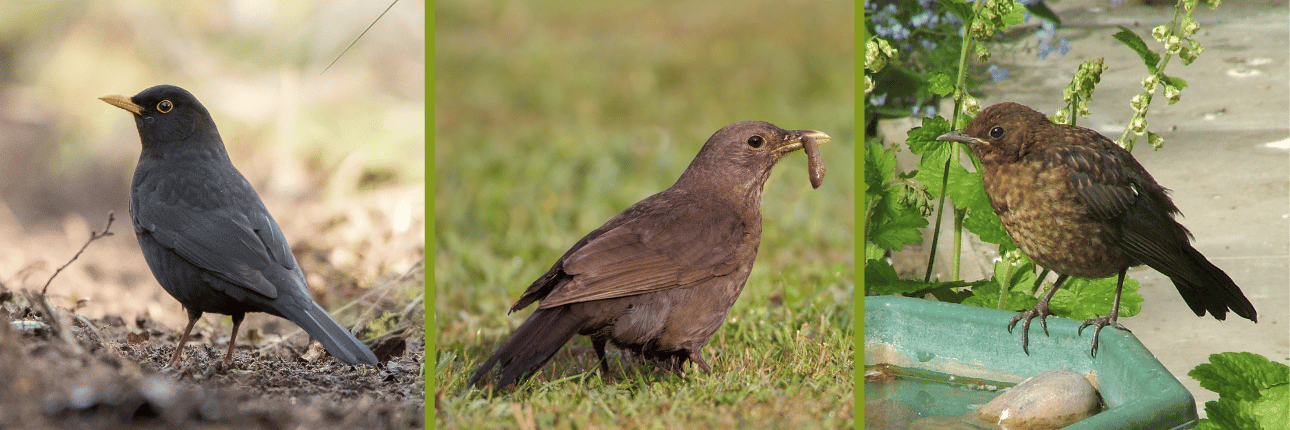The 2025 spring survey season began on 13 April and is now live.
Find out what's involved in taking part, how you can sign up and what you need to do before your first survey.
What skills do I need to take part?
If you have access to a garden, have an interest in garden birds and can recognise a Blackbird by sight, including reliably separating adult male, adult female and juveniles, then the Blackbirds in Gardens survey could be for you.
We will provide you with a simple identification guide to Blackbirds of both ages and sexes along with some confusion species once you have signed up.
blackbirds_sarah_kelman_liz_cutting_josie_latus_bto.png

How much time does it take?
Taking part in the Blackbirds in Gardens survey has a target of one 15-minute survey per week throughout the survey period (April–September). However, you can miss weeks and you can undertake multiple surveys within a week if you wish.
The survey week runs from Sunday to Saturday, and the survey itself is designed to fit around everyday life activities – it can be done at any time of day, and at different times each week.
Collecting and submitting data
Survey instructions
Each weekly 15-minute survey count is split into three five-minute segments and can start at any time of day. You should record the overall start time when you begin.
We have provided an example blank recording sheet you can use to help you do your surveys offline.
During each five-minute segment, you should record:
- The peak counts of adult males, adult females, juveniles and any unknowns seen at any one time across the segment within your garden recording area.
- If you observed Blackbirds doing any of the following behaviours:
- Foraging for natural food
- Using supplementary food (e.g. bird food or scraps you have put out)
- Feeding young/carrying food
- Using a man-made birdbath
- Using a pond or puddle
- Territorial chasing (note we are not specifically recording singing)
- Carrying nesting material
- An overall peak count of the most individuals seen at any one time (across all ages/sexes). This is the maximum count of Blackbirds you saw at any one time and may be different to the sum of the age/sex totals.
Are zero counts useful?
Yes! Even if you don’t see a Blackbird during your survey this is still important information for understanding how Blackbirds are faring and how they use gardens. In particular Blackbird numbers in gardens naturally fall in gardens in late summer before starting to rise again in the mid-autumn and we are keen to pinpoint when this happens. So please submit zero counts if you have them.
Submitting your survey data
After you have signed up, you can log in to the Blackbirds in Gardens web app to start entering your survey data.
For full instructions for submitting data, read our data entry guide.
Project results
During the winters following the two survey seasons, we will report back to all survey participants with the overall survey results for that year. We will also report on any subsequent publications using data from this survey.
Resources
Before you do your first survey
After you have signed up, you need to add your garden details in the Blackbird web app. For full instructions for setting up your survey site, see our data entry guide.
- If you participate in BTO Garden BirdWatch and have a relatively current set of garden details, there is an option to import your garden details within the Blackbird / Usutu web app without needing to input them again.
How to record and submit your data
- Survey recording sheet (PDF)
- View and enter your data - read our data entry guide for full instructions.
- Frequently asked questions (PDF)
How to sign up
If you are not an existing Blackbirds in Gardens volunteer, and you would like to join the project, please sign up!
If you already have a MyBTO account:
- Log in to MyBTO
- Then look for Blackbirds in Gardens under "Sign Up for Projects" and click "Register".
If you don't have a MyBTO account:
- Create a free MyBTO account
- Then look for Blackbirds in Gardens under "Sign Up for Projects" and click "Register".